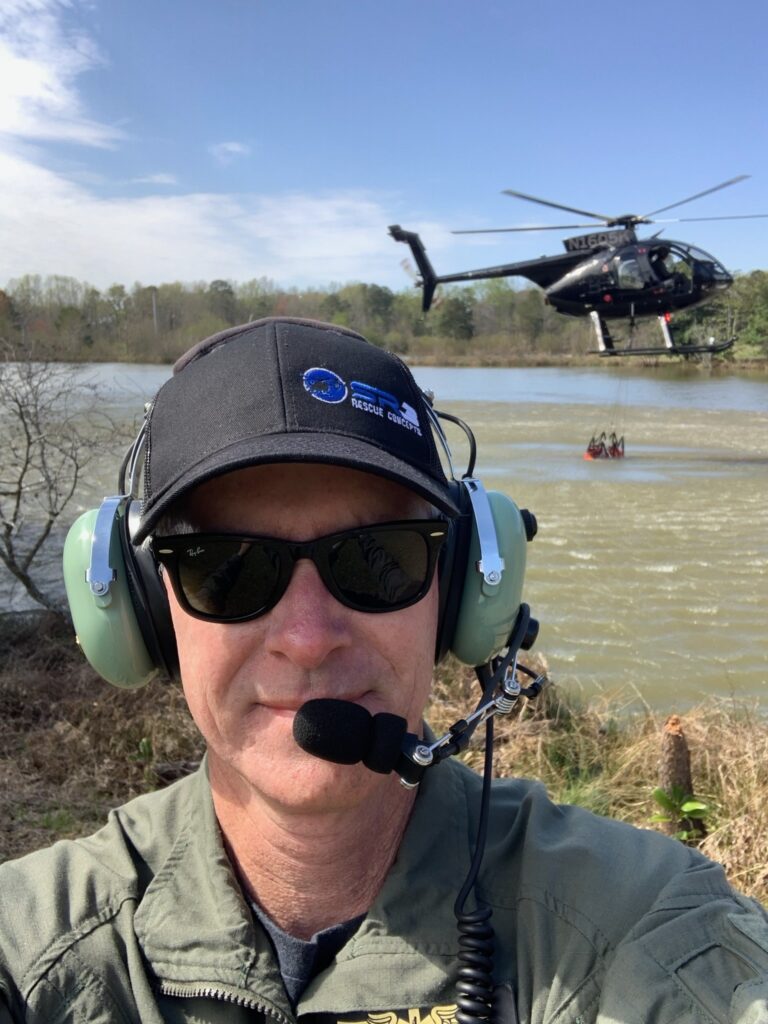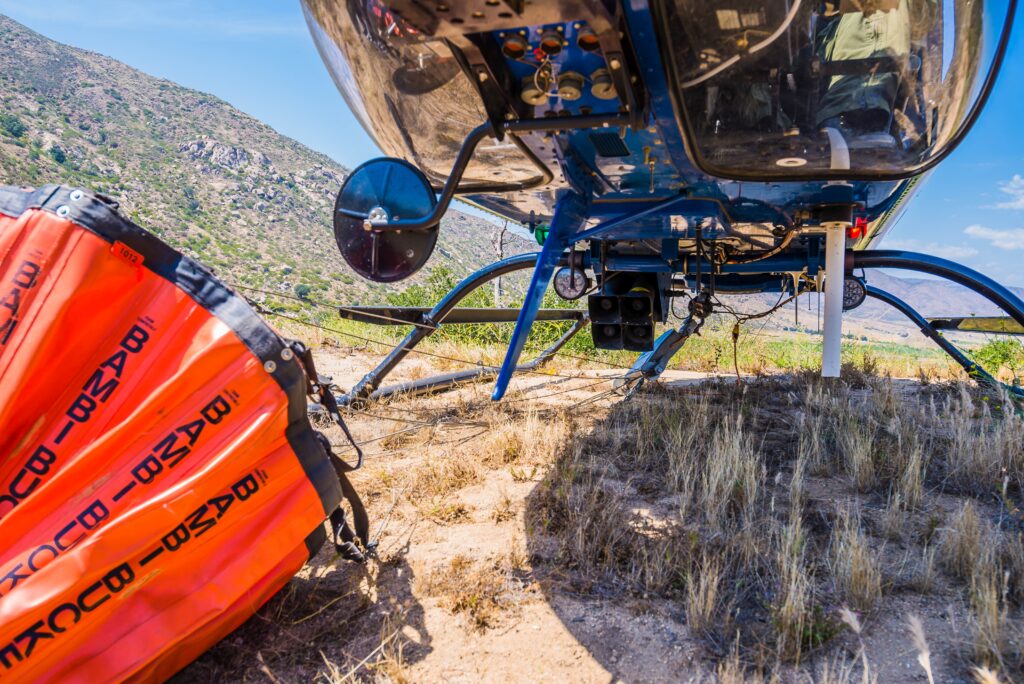By Nancy Argyle
Law enforcement may not be the first agency that springs to mind when fighting a wildfire, but the San Diego County Sheriff’s Department has been doing just that for more than 40 years. Equipped with an impressive suite of fire suppression tools and partnered with CAL FIRE firefighters, the agency has been able to dedicate crews and helicopters full-time to meeting the needs of the county it serves.
“The reason we’re so involved in aerial firefighting is that there are times that fire season runs all year,” says Tony Webber, a San Diego County Sheriff’s Department fire rescue pilot. “Our weather is great here, but the downside is that we have fires.”
As an ASTREA unit (Aerial Support to Regional Enforcement Agencies), the San Diego County Sheriff’s Department aviation division has two helicopter fleets: one for law enforcement patrols (four Bell 407 GXIs) and the other for fire rescue services (three Bell 205 and one new Bell 412 EPX). Any law enforcement agency in the county can request one of these helicopters and there’s no charge to victims for rescue. In 2023, so far, the fire rescue fleet has provided fire suppression for 46 fires and been involved in 98 rescues, 43 of which were advanced life support (ALS) calls.

Servicing the entire 4,200 sq. miles of San Diego County, fire rescue pilots like Webber can find themselves flying missions that stretch from coastal beaches to challenging mountainous terrain. A typical day for a fire rescue pilot starts early with a pre-flight of the aircraft (at any given time, two helicopters are always available). It’s time to meet their fire partners, take part in a briefing, review the weather, and see what’s happening and what resources are available. Once seat assignments and roles for the day are determined, it’s time to start actioning fires and rescue calls.
Fire missions can be urban interface fires, canyon and brush fires, or wildfires that would benefit from aerial suppression. Typically, one helicopter is used to transport and deploy CAL FIRE initial attack crews while the other helicopter is set up for hoist rescues.
“The helicopters are owned and operated by the San Diego County Sheriff’s Department while our partnership with CAL FIRE supplies the helitack crews,” Webber explains. “One rescue specialist is also a fully trained CAL FIRE paramedic.”
“You need highly trained and proficient crews to do this work,” he adds. “The pilot can’t see what’s under the helicopter, so you’re getting instructions from the hoist operator, and it can be a very unforgiving environment.”
For decades, the San Diego County Sheriff’s Department used Bambi Buckets as their go-to fire suppression tool until, in 2005, after a massive firestorm two years earlier, they could fund and dedicate a fleet of helicopters to fire response and permanently mount Simplex tanks.
“Most law enforcement agencies, doing fire-fighting part-time, are not going to spend the money on tanks or won’t want to attach a fixed tank, so the Bambi Bucket is the way to go,” Webber says. “It’s a great tool, and agencies who don’t do fires all the time will run a Bambi Bucket.”
With more fire seasons lasting the entire year in Southern California, agencies with the ability to respond to a fire means “everyone can help and go work a fire,” says Webber. “It’s very easy to grab a bucket, it takes minutes to deploy, and it’s convenient.”
“Before 2005, we would help local agencies with Bambi Buckets, and today, we still use the Bambi Bucket on the patrol Bell 407s as a fire backup helicopter when one or two of the Bell 205s are not available or in maintenance,” says Webber. “We have a 120 and 140-gallon bucket for the Bell 407.”

Like the aviation division of the San Diego County Sheriff’s Department, the Bambi Bucket is also 40 years old and used in 110 countries worldwide for wildfire suppression. While dozens of Bambi Buckets are typically tasked to fight wildfires due to their ability to provide precise, targeted drops, a law enforcement agency with a single bucket can still make a huge difference in stopping the progression of a new fire in their area. Suppose a lightning strike has set a tree on fire in a remote location. In that case, a law enforcement agency can easily keep that fire from spreading until ground firefighting crews can arrive to put it out, notes Webber.
“The cool thing is that the Bambi Bucket is a very simple design, and the things that can go wrong are very few…it’s been around this long for a reason because it has a bullet-proof design.”
After nearly 20 years of flying with Bambi Buckets, Webber now teaches other agencies who are just getting started with their first Bambi Bucket. As a contracted instructor with SR3 Rescue Concepts, Webber says, “It’s great to start with a new pilot who has never had a bucket hanging off the hook and then leave, at the end of training, confident knowing they will be safe.”
Webber also remains a full-time fire rescue pilot with the San Diego County Sheriff’s Department, where his days are both rewarding and, sometimes, very memorable. That happened with a hoist rescue in a remote area of San Diego County for a female hiker with a broken ankle. Webber says, “It was already late in the day, and we were racing to get the rescue done before it got dark. Darkness puts a whole new dynamic on a hoist rescue.”
Once on scene, the crew sent their hoist rescuer down to the victim while Webber’s helicopter orbited the area. “After about 10-15 minutes, our rescuer radios back up to us that they are ready to be hoisted up to the helicopter but that he has a problem. He says the victim has three large Labrador dogs, and she is NOT leaving them behind.”
It is starting to get dark, and the helicopter is getting low on fuel. “We can’t leave her behind, and we can’t force her into the helicopter. We know if we leave the dogs behind, the coyotes would probably kill them overnight.”
With no dog harnesses onboard, Webber must think fast. He suggests emptying the largest hoist rescue bag that has a heavy-duty zipper. “We tell our rescuer to stuff all three dogs into the bag and zip tie the zipper closed so it does not open while we are hoisting the dogs up to the helicopter.”

“When I saw the bag in the cargo mirror below the skid, I could see the bag moving with the dogs inside and started laughing while holding the hover,” says Webber. “After we got everyone up to the helicopter, we landed in a clearing where an ambulance was waiting to take our victim to the hospital. Our guys carried the bag with the dogs outside the turning rotor blades and opened the bag just enough for three Labrador heads to pop out. Our rescuer said all three of their tails were wagging, and they were as happy as could be.”
With a first time for everything, the San Diego County Sheriff’s Department rescue helicopters now carry dog hoist rescue harnesses in three different sizes to make sure they can continue to help everyone in need.
From dog hoists to aerial firefighting, this fleet of law enforcement helicopters often provides life-changing support to the citizens they serve – even the ones with paws.


